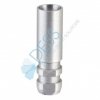- Messages
- 170
- Reaction score
- 16
Scan body. If you wanted to use your file you could but it's a very sloppy way.
Don't think so.Is it possible to create an insertion jig that would hold a standard analog, that you could insert into the model.
Bob
True, that technique does not work for a screw retained case. Yes, there has been a resurgence in SR cases but I see more than 50% of cases still cementable when I visit labs.
Rkm
Yes you can McGyver an analog in to a printed or milled model as alluded to by cnhart. Make a seating jig over the scan body and the adjacent teeth. Remove the incorporated scan body and create a hole in the model for the analog. Now take a real scan body of the same type and attach an analog. Utilize the seating jig to reposition the scan body-analog assembly back on to the model and bond the analog in place with light cure material.
Have done this a couple of times for Biohorizons cases with the 3in1 abutment as the scan body. Worked like a charm.
Until we have a solution for this; McGyver or accept only Straumann cases.Here we go. We're talking digital impressions and digital models for implants. This is an automated workflow. any automated workflow should either save time or money or both. This "McGyver" approach definitely does not fit that bill. But, I agree it could be done and probably would work well for single units. However, longer term, we need a solution that is faster and or cheaper using printed and milled models.
3d printed models with stainless steel analogs
Hi Lance-
Thanks for the picture of the analog with the flat bottom.
Has anyone figured out a way to use a standard analog in a 3d printed model by either having it printed where the pieces split down the middle of the implant site to insert the analog.
I have the stl library files that we give away for exocad, 3shape, and dental wings and our analogs have a flat side at the bottom of it so I am starting to talk to the stratsys /objets and other printer manuf to figure out a solution.
I think it would be tough to bring in an analog from the bottom of the model and orientate it properly.
Any input on possible workarounds and options I would like to know since my customers are dental labs asking me for this solution and there are plenty of labs that are tired of being locked into using a milliing center for this proprietary solutions and want options.
thanks
Keith Goldstein
DESS USA
DESS-USA | Dental Implants & Restorative Prosthetics
[email protected]

I believe standard analogs will need a redesign to facilated digital models.
I don't think the exterior of the analog would need to be shaped like an implant. The geometry would simply need a vertical and rotational stops.
No, a dowel pin will not work due to the taper. The taper will result in some potential error in the vertical location of the analog. There will need to be a shoulder to act as an exact vertical stop built into the design.Like a dowel pin?
I know nothing about printing, however, Seems like an easy way would be to have the software see the long access of the fixture based on the scan body. Perhaps the digital model could be then oriented via software to line up to the build plate on a 90* angle to the base of the fixture. The build plate would have a jig to insert standard analogs that the software would reference and then the model would be printed around the analog.
Seems easy, ok pay me the money!
Call 3i-Biomet and ask them to give up the goods on how they do the Encode...lol

